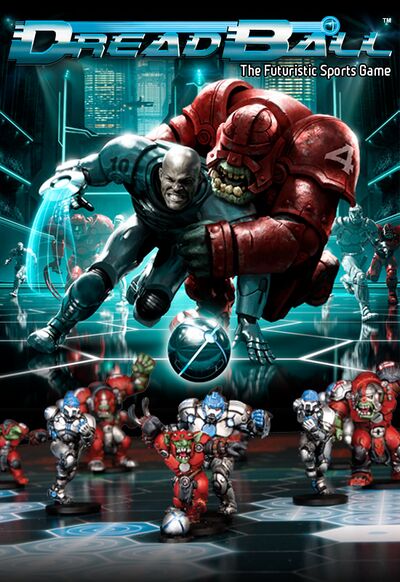Dreadball

Dreadball is Mantic Games' most exciting game by far, a marvelous mix of design and theme that blends sports with warfare in a great way.
Originally, Dreadball appeared to be a joke, and used to be compared to Blood Bowl. But, over 8 years since its original publication, with 2 editions (and one really XTREME wargamish spinoff) and 7 seasons worth of teams, Dreadball is becoming its own creation. If Blood Bowl is the grandfather of grid based miniature sports games(that's a weird title to be honest), Dreadball is the angsty teenager that is finally becoming its own man. A very violent and fast man.
Thing is, comparing dreadball to blood bowl could be a great way of comparing how eurogame mechanics have meshed with traditional mini wargame design, as well as how wargames have changed in their scale and scope. Dreadball is a game where the player controls fewer players than in blood bowl (6 instead of 14, actually 14 is the maximum amount of players a roster can have) and instead of activating all of them, he uses activation tokens, a really euro mechanic. Also instead of scoring touchdowns, players need to score strikes, which means, yes, shooting on goal rather than running towards it. And players don't reset their formation after a strike is scored. So in dreadball players don't just need to score, they are also required to defend properly, and since scoring ends a player turn, planning is vital. Oh, and did we mention the part where strikes are recorded in a shared score track, where the marker is moved towards one part or the other, and if a player ever reaches 7 unopposed points he wins by a landslide? Yep, in dreadball the scoring mechanism is more dynamic while being no less brutal than in Bloodbowl.
Finally, Dreadball teams are quite streamlined when it comes to composition, having only 3 types of player (guard, jack and striker) who are unevenly distributed in all teams, some have all 3, others just 2 out of three and 2 teams (Tsudochan and Zee) only have jacks. This makes the game easy to memorize when it comes to it's core mechanics, while not taking away flavour from the teams, since each has its own rules and stats.
With 30 teams, dreadball offers a lot of variety to whoever desires to test the game. Teams go from the classical fantasy races IN SPAAACE, such as elves (offered in high and wood flavour), dwarves (offered in highborn and lowborn flavour, sort of), orcs and goblins (offered in orcs and goblins and hobgoblin with troll flavour), humans (in three variants, generic male, generic female and CONVICTS!!!!!, skaven and now sumo reptilians, to more sci fi themed games such as robots (in no less than three variants, 4 if you consider the cyborg zombie team), martians (of the Mars Attack variety) and mutants. And somewhere in the middle we have "original" mantic races such as the Tsudochan (yoda like creatures who can use the force. No really, they push people around telepathically), Judwan (air caste Tau who are actual pacifist instead of pretended pacifists), Sphyr (hammerhead sharkmen), Ada Lorana (beings made of energy), yindij (a race that has simian and feline like traits and lives in Khasshyk (That name is suspiciously similar to a Star Wars planet)), Crystallans (rock people that hate dwarves (think the trolls of Discworld)) and finally the just plain weird Koris(i don't really know how to describe them). Oh and also rebels in space and space chimps because why not.
Gameplay wise, you have roughly 4 types of teams, teams made for versatility (any human or robot team), teams made for scoring (judwan, elves yindij and skaven if they could actually hit something with their shit pass and shooting accuracy), teams made for hitting and turtling (dwarves, crystalans, reptilians and orcs and goblins) and finally teams that have a gimmicky but deadly ability (tsudochan, Monkeys and Koris mainly).
But, the great thing about Dreadball is that while a team may have advantages favouring a certain play style, that doesn't mean that said team can only play said style, thus enabling the player to adapt and reform his play style to counter his opponent without the need for tailoring his team roster. EG: Orcs can't play their natural tackling game against dwarves, because they would be outclassed, hence they can adapt to use a more scoring focused ability, or wood elves (Kalishy) can't defeat judwan in a scoring competition, unless they use their attacking bonuses to maximum efficiency, thus becoming more of a hitting team rather than a scoring one.